Zoom
Trash

10 Writing Rules You Can't Break...And How to Break Them. A guest post by Eric Cummings of On Violence First, there was the “old school.”
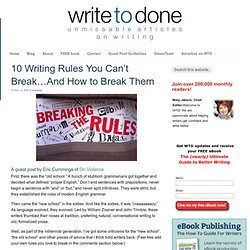
A bunch of stubborn grammarians got together and decided what defined “proper English.” Don’t end sentences with prepositions, never begin a sentence with “and” or “but,” and never split infinitives. They were strict, but they established the rules of modern English grammar. Then came the “new school” in the sixties. Well, as part of the millennial generation, I’ve got some criticisms for the “new school”, “the old school” and other pieces of advice that I think hold writers back. 1. This advice is considered gospel for a reason: nothing is worse than confused, labyrinthine prose. At the same time, clear writing is different than simple writing. How to Start and Finish Writing a Novel. Practical Tips on Writing a Book from 23 Brilliant Authors. Hello there! If you enjoy the content on Neurotribes, consider subscribing for future posts via email or RSS feed. Steve Silberman reading at the Booksmith in SF. Photo by Heather Champ.
I love books. My late father Donald, who taught Wordsworth and Melville to inner-city kids for decades, used to read Ulysses to me while he carried me on his shoulders. The subject of my book is autism, the variety of human cognitive styles, and the rise of the neurodiversity movement. The science of developmental disorders has made significant advances in recent years, and some of the social issues that I raised in the piece — such as the contributions that people with atypical cognitive styles have made to the progress of science, technology, and culture — seem more relevant than ever. Tips for Editing Your NaNoWriMo Novel. I have been writing fiction for 30+ years and regularly critique the work of others.
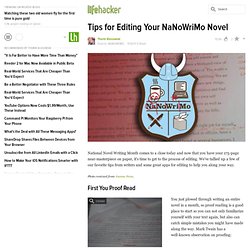
The best general advice I can offer is to learn why the rules are important and when to break them. No writing 'rule' will make you a good writer. They are guides to help you avoid mistakes in your technique. For example: One of the most abused rules of writing is to eliminate the passive voice, often by searching and eliminating forms of 'to be' (is, am, are, was, were). Passive voice disconnects the character from the action, making it seem to happen without their driving force. The problem with simply eliminating the passive voice is I can offer a dozen good examples of reasons when the passive voice is not only acceptable, but preferred. 1) When the the character or actor is unknown or hidden. 2) When you want to highlight the action over the actor. 3) When the character is depressed, equivocal, or unable to decide. 5) In some contemplative, self-reflective character examination situations.
How to Publish Your Own Amazon Kindle Ebook. Would you like to be the next Dan Brown or J.K.

Rowling? Perhaps your aspirations are less lofty, but you still have a story--or expert information--to share with the masses. Unless you are already a bestselling author, landing a publishing deal is easier said than done. Thankfully, though, tools are available for you to publish your own electronic book. I'm no stranger to publishing, having written or cowritten a dozen books. For a small or medium-size business, self-publishing has a variety of potential benefits. You have assorted options, including Amazon's CreateSpace and Kindle Direct Publishing; Barnes & Noble's PubIt; Lulu; and SelfPublishing.com.
If writing an entire book seems daunting, you might prefer to take an existing blog of yours and publish it via Amazon so that everyone with a Kindle can download and read your posted material. How to self-publish an ebook. A while back I wrote a column titled "Self-publishing: 25 things you need to know," which was mostly about how to create and sell your own paper book.
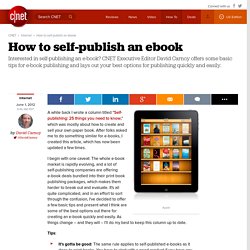
After folks asked me to do something similar for e-books, I created this article, which has now been updated a few times. I begin with one caveat: The whole e-book market is rapidly evolving, and a lot of self-publishing companies are offering e-book deals bundled into their print book publishing packages, which makes them harder to break out and evaluate. It's all quite complicated, and in an effort to sort through the confusion, I've decided to offer a few basic tips and present what I think are some of the best options out there for creating an e-book quickly and easily.
As things change -- and they will -- I'll do my best to keep this column up to date. Tips: How To Write A Novel Using The Snowflake Method. Writing a novel is easy.
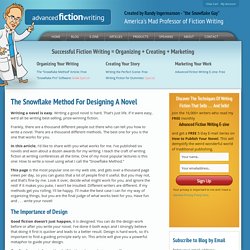
Writing a good novel is hard. That’s just life. If it were easy, we’d all be writing best-selling, prize-winning fiction. Scrivener. Camp NaNoWriMo. How To Write A Novel Step by Step. The toughest part of learning how to write a novel is knowing where to start and how to keep on going to the end.
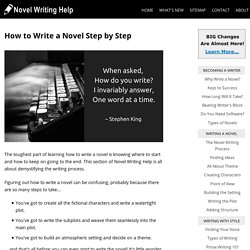
This section of Novel Writing Help is all about demystifying the writing process. Figuring out how to write a novel can be confusing, probably because there are so many steps to take... You've got to create all the fictional characters and write a watertight plot. You've got to write the subplots and weave them seamlessly into the main plot. You've got to build an atmospheric setting and decide on a theme. ... and that's all before you can even start to write the novel! Where do I even begin?!? The answer is that you begin by studying a good map and familiarizing yourself with the route. Actually, it is two maps in one...